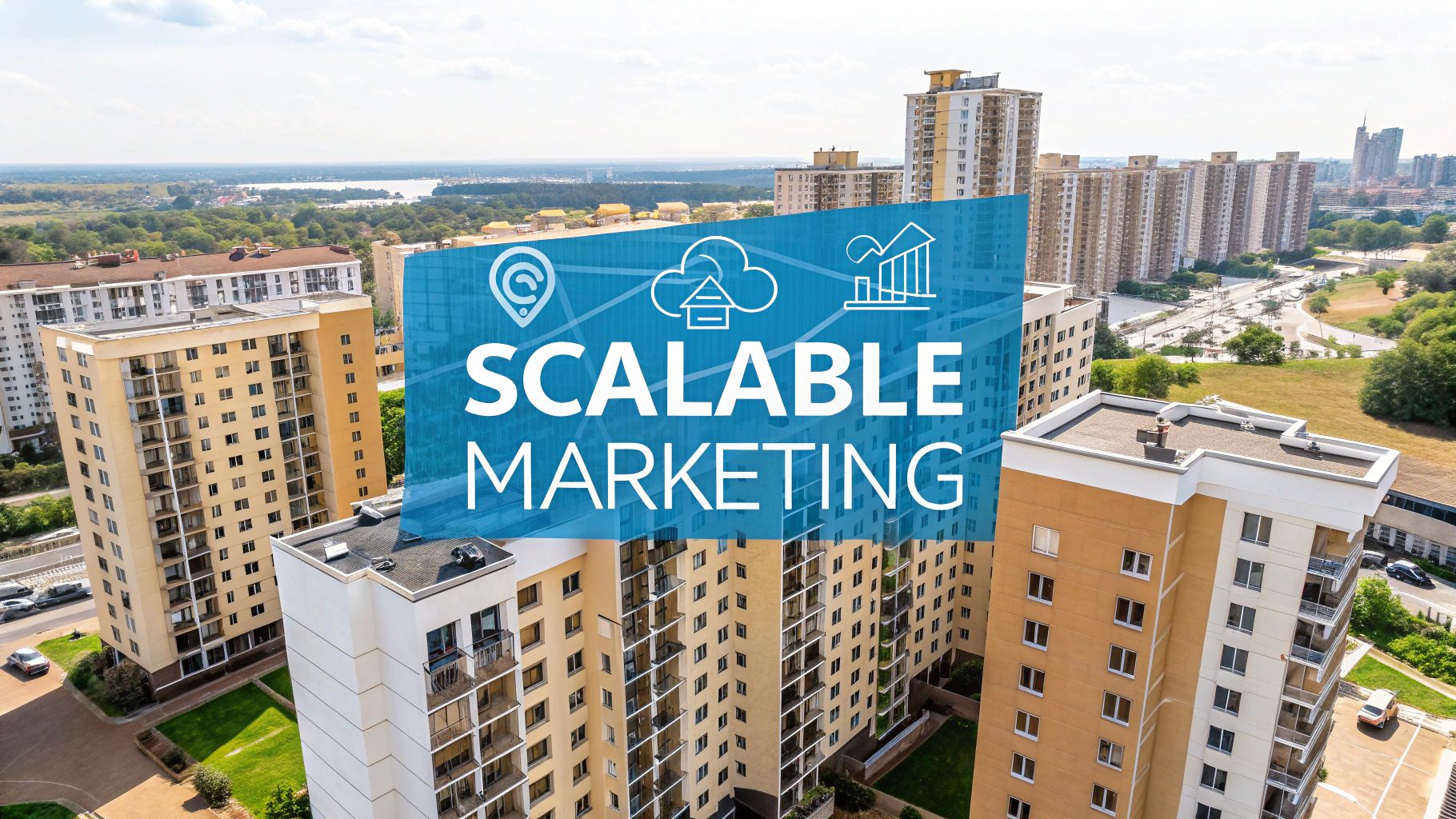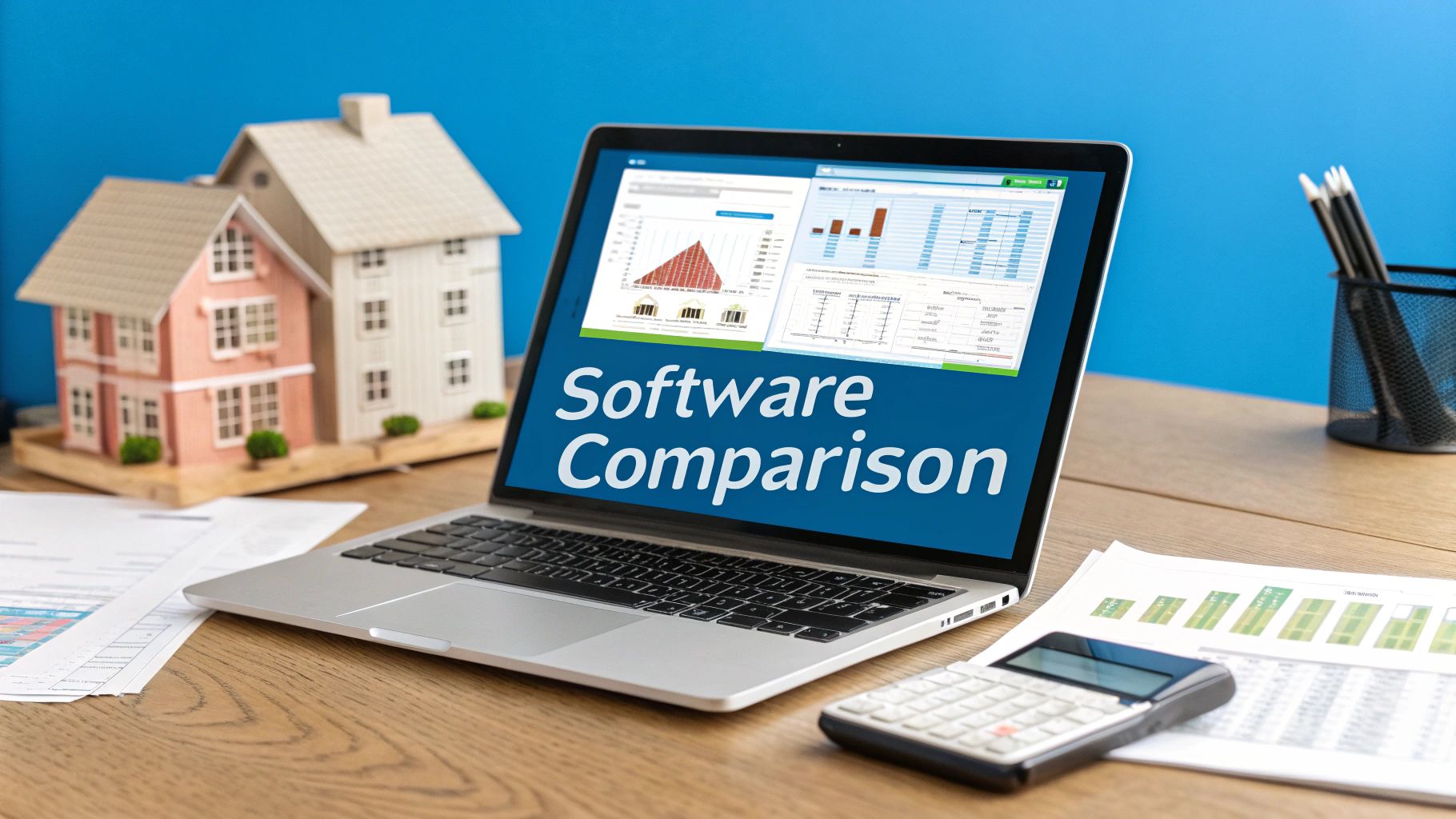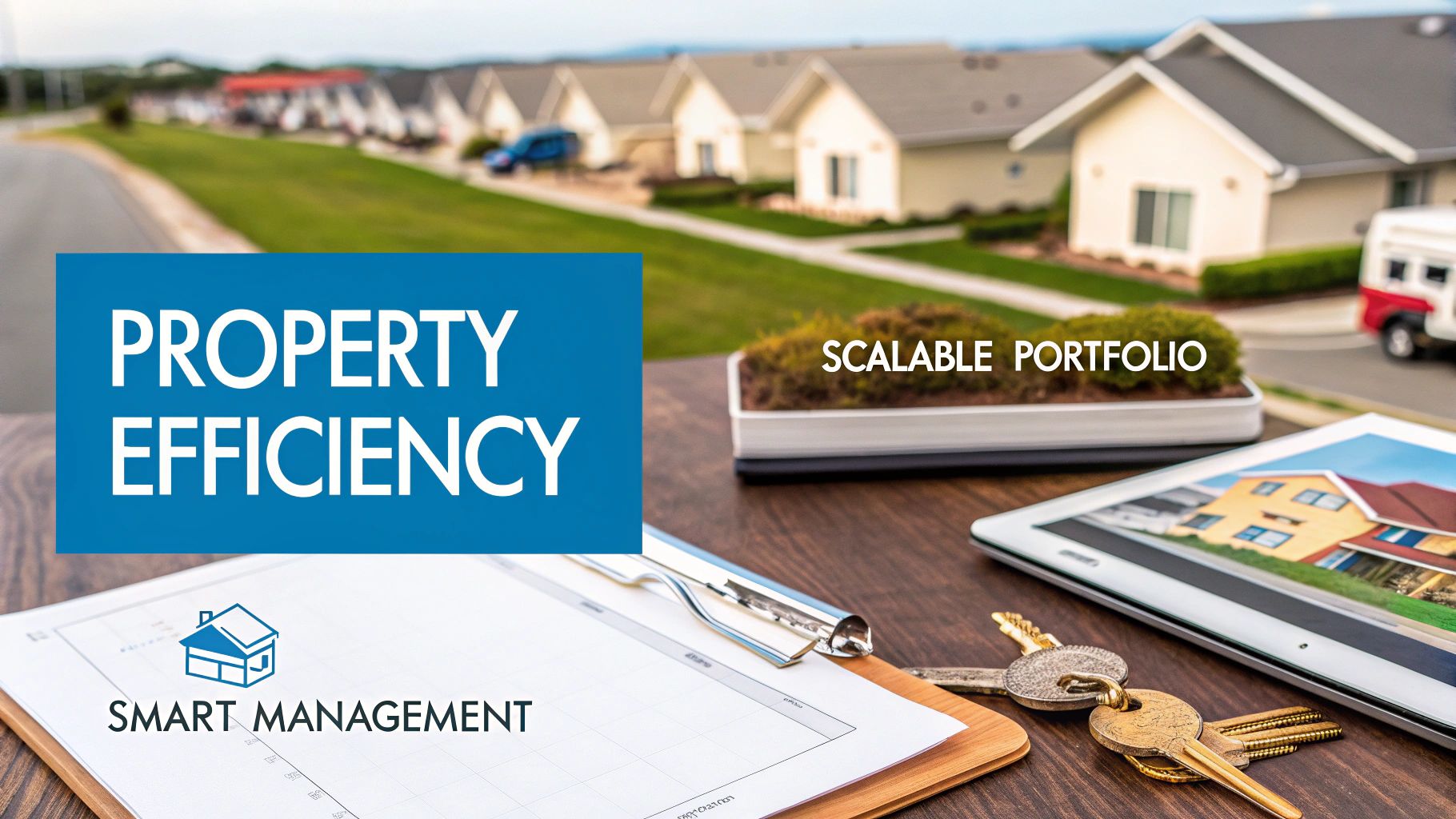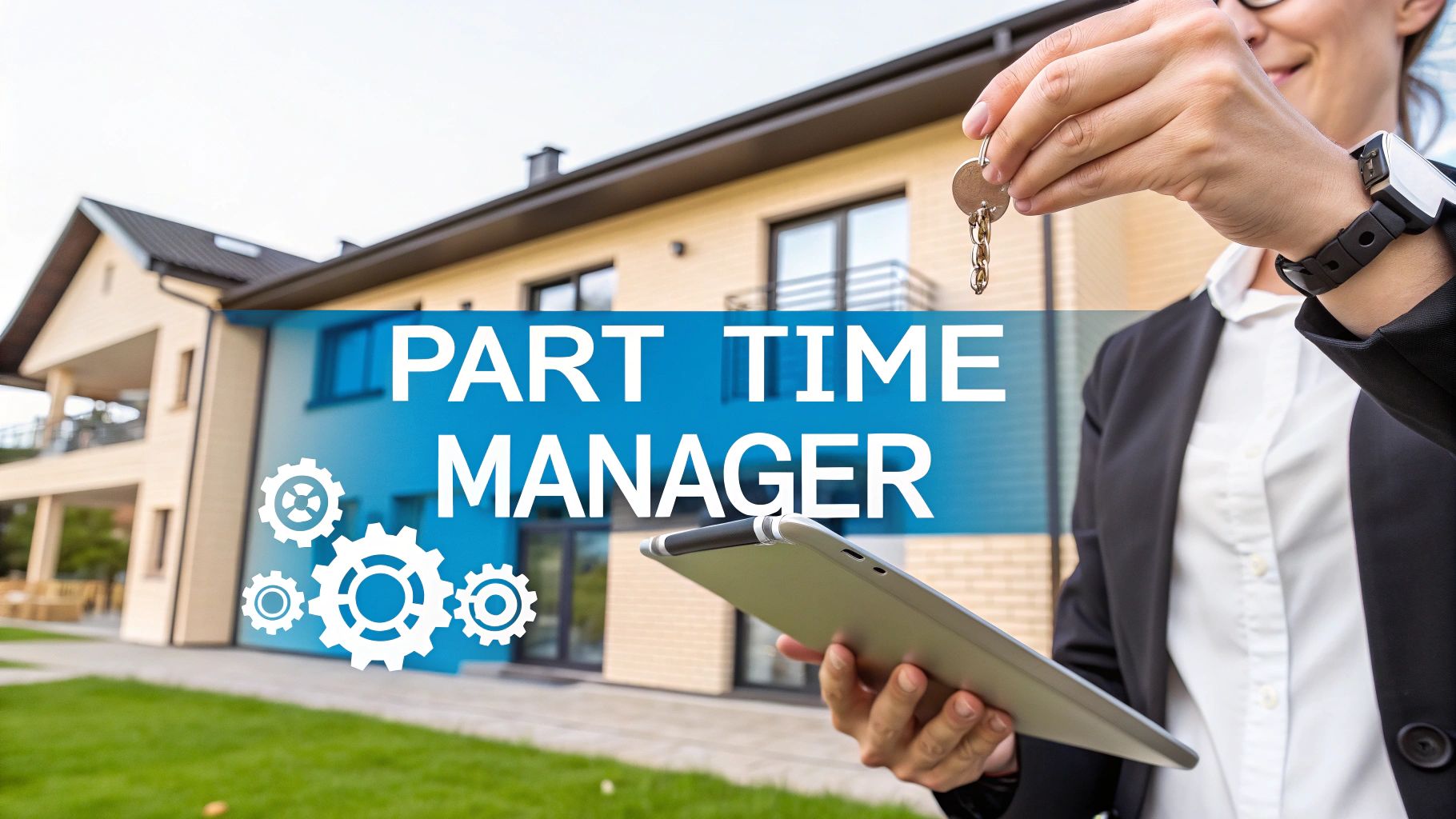For property management companies managing 100 to 10,000+ units, traditional apartment marketing ideas are insufficient. The core challenge isn't just filling one vacancy; it's systemizing lead generation and conversion across a distributed portfolio to slash Days on Market (DOM) and maximize revenue. Every day a unit sits empty erodes profitability—a loss that multiplies exponentially at scale. For a 1,000-unit portfolio with an average rent of $1,700, a single day of vacancy across all units represents over $55,000 in lost revenue. This reality demands a shift from passive listings to proactive, data-driven marketing engines.
This article moves beyond generic advice to provide nine high-impact, scalable apartment marketing ideas designed for tech-forward operations teams. We'll explore strategies that directly address enterprise-level pain points, from optimizing lead-to-tour conversion rates to building a robust, remote-first leasing engine that drives measurable ROI. For organizations managing extensive portfolios, a robust digital presence is key. To enhance your overall leasing strategy, explore proven strategies for mastering enterprise-level PPC management that can be adapted for large-scale property marketing. Each idea presented here is chosen for its ability to integrate into enterprise systems, reduce cost-per-acquisition (CPA), and ultimately, accelerate your speed-to-lease across every property you manage.
1. Deploy Immersive Virtual Tours & 3D Walkthroughs to Qualify Leads Remotely
In today's competitive rental market, one of the most effective apartment marketing ideas is leveraging technology that qualifies leads before a showing is ever scheduled. Immersive virtual tours and 3D walkthroughs are essential tools for property managers overseeing large, geographically dispersed portfolios without onsite staff. These digital assets allow prospective tenants to explore a unit’s layout, finishes, and flow from anywhere, at any time, filtering out unqualified prospects early in the process.
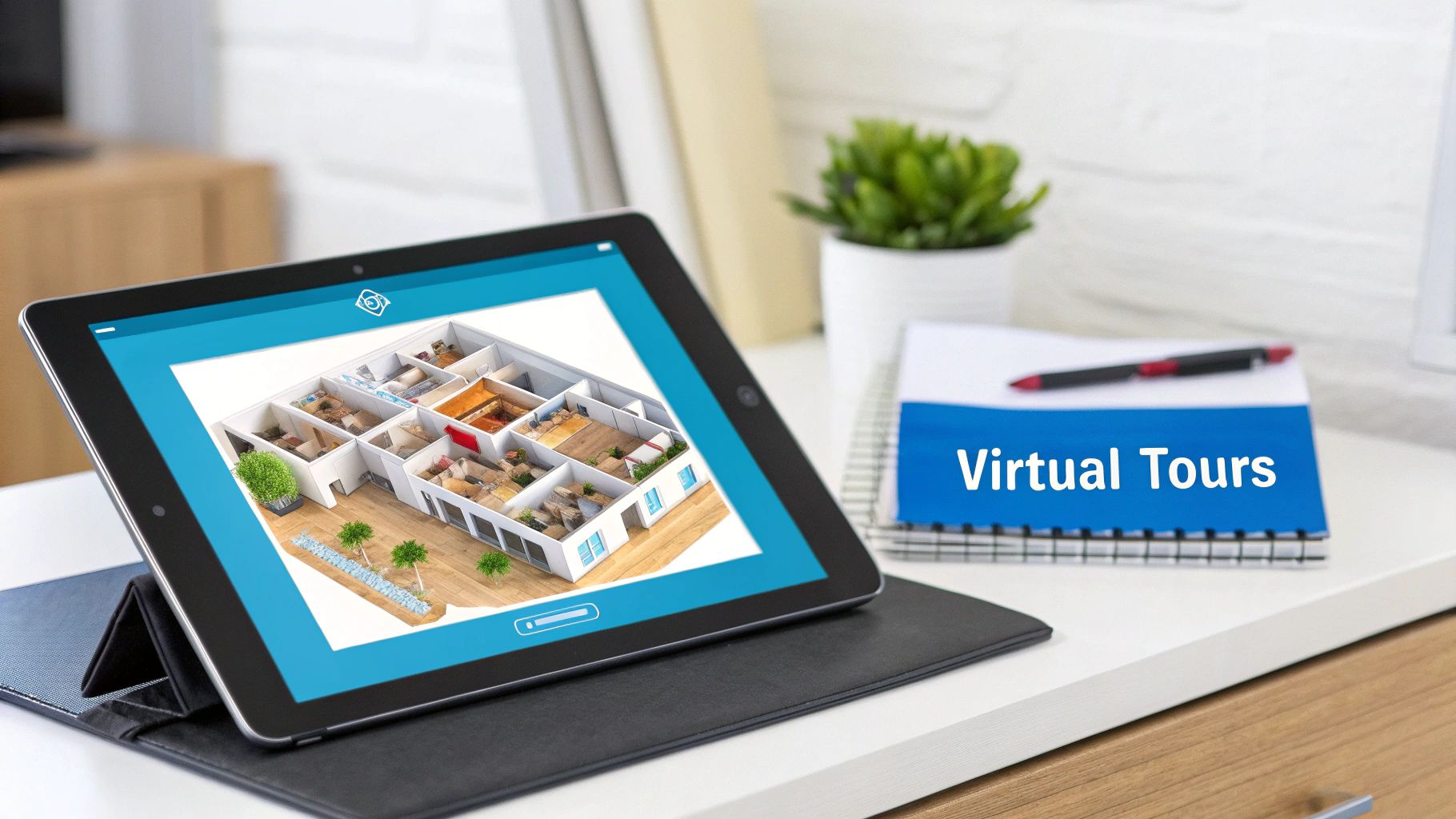
By providing a high-fidelity, interactive experience, you ensure that the prospects who do request an in-person tour have a much higher intent to lease. According to Zillow, listings with a 3D tour receive 40% more saves from renters. This pre-qualification dramatically improves your lead-to-tour conversion rates and reduces wasted field agent time, directly lowering your cost-per-lease. Furthermore, these tours accelerate the decision-making process, helping you cut down on Days on Market (DOM) and minimize revenue loss from vacancies.
How to Implement This Idea:
- Choose Scalable Technology: Utilize established platforms like Matterport or Zillow 3D Home to create professional, high-quality tours. Ensure the chosen solution offers API access for seamless integration with your Property Management Software (PMS) and listing sites.
- Prominently Display Tours: Embed the virtual tour directly within your online listings, ideally above the fold, next to primary photos. Do not hide it behind a "request tour" gate; the goal is to qualify leads upfront.
- Track and Optimize: Use analytics to monitor tour engagement and completion rates. Correlate this data with application submissions to identify which unit features are driving conversions, informing future marketing and capital expenditure decisions.
- Establish a Refresh Cadence: For portfolios with standardized unit types, create evergreen tours. For unique units, establish a process to capture new 3D tours as part of the turnover process to ensure content is always current.
For more details on how these tools can transform your remote leasing operations, you can learn more about the benefits of virtual tours for property managers.
2. Leverage Social Media Influencer Partnerships to Build Authentic Buzz
One of the most powerful apartment marketing ideas for reaching specific demographics is collaborating with social media influencers. This strategy involves partnering with local or niche content creators to amplify your community's brand voice and showcase its unique lifestyle. Influencers produce authentic, relatable content, such as apartment tours, day-in-the-life vlogs, or sponsored posts, that resonates with their highly engaged followers in a way traditional advertising cannot.

For large-scale property managers, this tactic is exceptionally effective for targeting specific renter profiles, from students in a college town to young professionals in a bustling urban center. A well-chosen influencer partnership can drive a significant volume of qualified traffic to your listings and generate a powerful sense of social proof, making your properties highly desirable. This targeted exposure creates pre-qualified, enthusiastic leads, which directly contributes to reducing Days on Market (DOM) and maximizing portfolio revenue.
How to Implement This Idea:
- Vet Influencers Strategically: Look beyond follower counts. Use tools to analyze an influencer's engagement rate, audience demographics, and past brand collaborations. Prioritize micro-influencers (10k-50k followers) with strong local ties for higher engagement and ROI.
- Define Clear KPIs and Deliverables: Structure your collaboration with a formal agreement outlining specific deliverables (e.g., one Instagram Reel, three Stories, one blog post), usage rights, and key performance indicators (KPIs) like link clicks, inquiries, or application submissions tracked via unique URLs.
- Encourage User-Generated Content (UGC): Maximize the campaign's impact by creating branded hashtags and photogenic "Instagrammable" spots within your community. Encourage the influencer to promote these, inspiring their followers and your residents to create and share their own content.
- Align Partnerships with Leasing Cycles: Launch influencer campaigns strategically during peak leasing seasons or to promote a newly available block of units. For example, partner with campus personalities in the spring to target students looking for fall housing.
3. Host Community Events & Local Sponsorships to Build Hyper-Local Brand Authority
One of the most impactful apartment marketing ideas involves embedding your brand directly into the fabric of the local community. By hosting or sponsoring neighborhood events like block parties, charity runs, or farmers markets, you transform your property from a simple collection of units into a recognized community hub. This hyper-local approach builds powerful brand awareness and fosters deep-seated goodwill, positioning your portfolio as an integral and active member of the neighborhood.
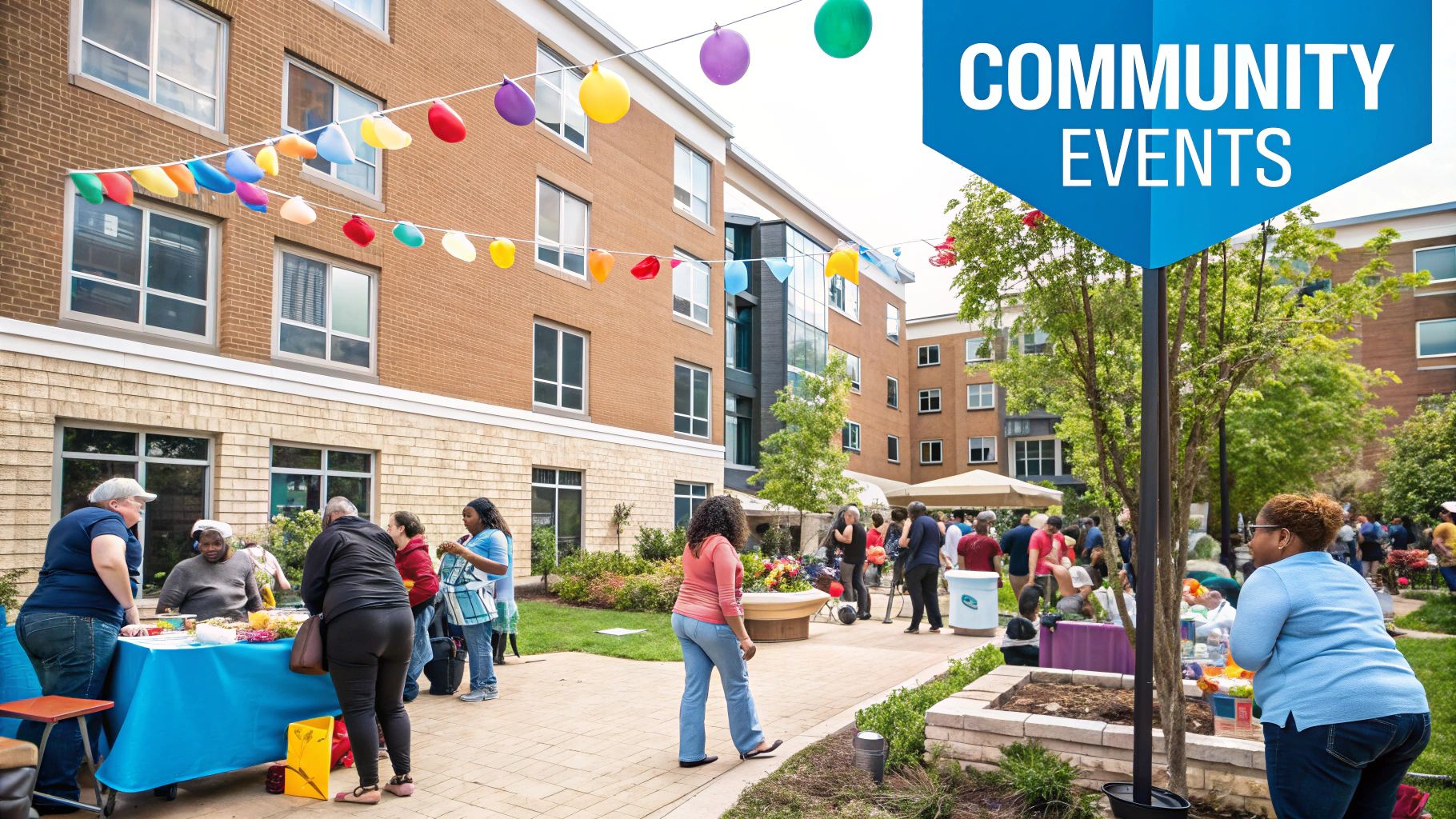
This strategy moves beyond traditional advertising by creating authentic, memorable experiences that attract both prospective tenants and top-tier residents. High-profile management companies like Camden and Bozzuto have mastered this by hosting events such as charity 5Ks and summer food truck festivals. These activities not only generate positive word-of-mouth but also create valuable content for social media and email newsletters, showcasing a vibrant and engaged community life that is highly attractive to potential renters. The result is a stronger brand reputation and a pipeline of leads who are already sold on the community lifestyle you offer.
How to Implement This Idea:
- Partner with Local Nonprofits: Select a popular local charity to co-host an event. This strategy amplifies your reach, adds a layer of goodwill, and attracts attendees who are passionate about supporting their community.
- Capture Leads Strategically: Use event sign-ins, raffles, or photo booth contests to ethically collect attendee contact information. Follow up with a thank-you message and an invitation to learn more about available units. To effectively implement these campaigns and nurture leads at scale, exploring the best email marketing services and platforms can be highly beneficial.
- Leverage Hyper-Local Promotion: Promote your event on platforms like Nextdoor, local Facebook groups, and community bulletin boards. This ensures you reach residents living in close proximity who may be looking to move or have friends searching for a new home.
- Focus on Experience: Design the event to be genuinely enjoyable, not just a sales pitch. A positive experience creates a lasting impression that translates into brand preference when attendees or their friends are searching for a rental.
4. Launch Referral Programs & Resident Rewards
One of the most powerful and cost-effective apartment marketing ideas is to activate your current residents as a high-quality lead generation channel. A well-structured resident referral program transforms satisfied tenants into enthusiastic brand ambassadors. By offering compelling incentives, you tap into existing trust networks, as recommendations from friends and family carry significantly more weight than traditional advertising. This strategy produces leads with a much higher intent-to-lease, directly lowering your cost-per-lease and accelerating the leasing cycle.
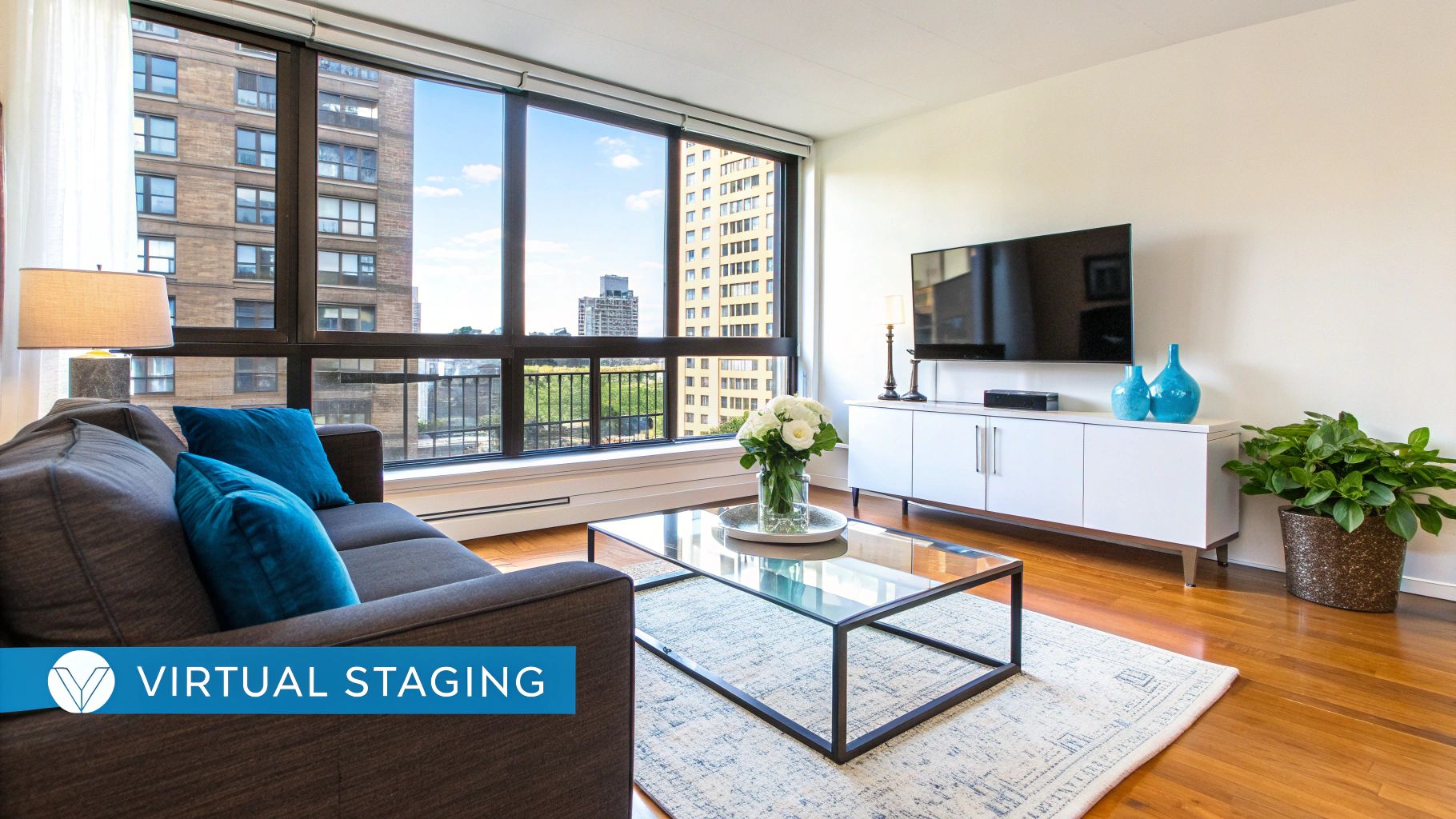
For large-scale portfolios, the impact is magnified. Leading property management companies like AvalonBay and Equity Residential have perfected this model, offering rent credits or valuable gift cards for successful referrals. These programs not only fill vacancies faster, reducing Days on Market (DOM), but also foster a stronger sense of community and improve resident retention. By rewarding loyalty, you create a virtuous cycle that supports both occupancy rates and long-term resident satisfaction, boosting your portfolio's overall financial performance.
How to Implement This Idea:
- Design a Clear Incentive Structure: Define simple, valuable rewards. Common options include a one-time rent credit ($250-$500), a high-value gift card, or an upgraded amenity package. Ensure the terms are easy to understand for both the referring resident and the new applicant.
- Automate Tracking and Payouts: Leverage your property management software (PMS) to automate the referral process. Create a dedicated field in the application form for the new prospect to name who referred them. This streamlines tracking and ensures timely, accurate reward distribution, which is critical for program trust at scale.
- Promote the Program Consistently: Market your referral program as actively as you market your vacant units. Use resident newsletters, community portal announcements, lobby signage, and email signatures to keep the program top-of-mind.
- Implement Fraud Prevention: Especially for large portfolios, establish clear rules to prevent abuse. Require the new tenant to sign a full lease term and pay their first month's rent before the reward is issued. Regularly audit the program's performance and payout logs.
5. Master Search Engine Optimization & Local Search
In an era where the tenant journey begins with a search query like “apartments in [city]” or “three bedroom rental near me,” mastering Search Engine Optimization (SEO) is no longer optional. This is one of the most fundamental apartment marketing ideas for driving high-quality, organic traffic directly to your listings. By optimizing your website, blog, and Google Business Profile, you can rank higher than competitors for the specific keywords prospective tenants use, capturing high-intent leads at zero acquisition cost.
This strategy is about ensuring your properties are highly visible when and where prospects are looking. For property managers with dispersed portfolios, a strong local SEO presence is critical for attracting tenants in specific submarkets and neighborhoods. It directly impacts lead volume and quality, giving you a sustainable competitive advantage over portfolios that rely solely on paid listing sites. A well-executed SEO strategy significantly reduces your reliance on expensive advertising and lowers your overall cost-per-lease.
How to Implement This Idea:
- Optimize Your Google Business Profile: A cornerstone of mastering local SEO and capturing high-intent 'near me' searches is optimizing your Google My Business and local SEO presence. Ensure your property name, address, phone number, and website are consistent everywhere online. Regularly upload high-quality photos and encourage residents to leave reviews to boost your local ranking signals.
- Create Neighborhood-Specific Content: Develop blog posts and landing pages that act as local guides, such as "Top 5 Restaurants in [Neighborhood]" or "A Guide to Parks and Recreation in [City]." This positions your properties as central to the community and captures long-tail keyword searches from prospects researching the area.
- Conduct Quarterly Technical Audits: Use tools like Ahrefs or SEMrush to perform regular audits of your website. Identify and fix technical issues like broken links, slow page speed, or poor mobile usability that can hurt your search rankings.
- Build Local Citations: Ensure your properties are listed accurately on major online directories like Yelp, Apartments.com, and local business directories. Consistent citations signal to Google that your business is legitimate and prominent in the local area.
6. Run Paid Digital Advertising & Geotargeting Campaigns
While organic reach is crucial, one of the most direct apartment marketing ideas for driving immediate, qualified traffic is through paid digital advertising. Platforms like Google Ads, Facebook, and Instagram allow property managers to run hyper-targeted campaigns that reach prospective renters with unparalleled precision. This approach moves beyond passively waiting for leads and actively seeks out tenants based on location, demographics, and online behavior.
By leveraging geotargeting and geofencing, you can place your ads in front of renters within a specific radius of your property, near major local employers, or even around competitor communities. This tactic is especially powerful for large portfolios, as it allows you to allocate marketing spend precisely where it’s needed most, maximizing your Cost Per Lead (CPL) and reducing marketing waste. Running dynamic retargeting ads can recapture the attention of prospects who visited your website but didn't inquire, dramatically improving conversion rates and accelerating your speed-to-lease.
How to Implement This Idea:
- Define Your Audience and Goals: Before launching a campaign, clearly define your ideal renter persona and establish a target Cost Per Application (CPA) and target DOM for the campaign. This ensures your ad spend is both efficient and outcome-focused.
- Utilize Geofencing: Set up campaigns on Facebook or Google Ads to target users within a specific geographic area. Consider geofencing competitor properties to capture the interest of renters who are actively touring other options in your submarket.
- Implement Retargeting Pixels: Install tracking pixels (like the Meta Pixel or Google Ads tag) on your website. This allows you to serve targeted ads to users who have already shown interest in your properties, reminding them to complete their application or schedule a tour.
- A/B Test Creatives: Continuously test different ad images, headlines, and calls-to-action every two weeks. This data-driven optimization is key to lowering your CPA and increasing your lead volume over time.
7. Email Marketing Automation & Drip Campaigns
Among the most scalable apartment marketing ideas is the implementation of email marketing automation. This strategy allows property managers to nurture leads from initial inquiry to signed lease through automated, behavior-based email sequences. Instead of manual follow-ups, triggered campaigns can share new availability, promote move-in specials, or deliver community news, ensuring consistent communication without overburdening your leasing team. This frees up staff to focus on high-intent prospects and closing leases.
Automated drip campaigns are particularly effective for large portfolios without onsite staff. By segmenting your audience, you can deliver highly relevant content that guides prospects through the leasing funnel. For example, a lead who views a specific floor plan online could receive an immediate follow-up email with a virtual tour of that unit, followed by an invitation to schedule an on-demand, in-person showing. This targeted approach dramatically increases engagement and lead-to-tour conversion rates, directly impacting your Days on Market (DOM) by accelerating the prospect’s decision-making process.
How to Implement This Idea:
- Segment by Behavior: Use platforms like Mailchimp or ActiveCampaign to create audience segments based on actions like which listings they viewed, if they opened a previous email, or if they completed a tour. This allows for hyper-personalized messaging at scale.
- Develop Nurture Sequences: Create a multi-step drip campaign for new leads. A typical sequence might be: 1) Instant welcome email with property highlights, 2) Follow-up with available floor plans and 3D tours, 3) Invitation to schedule an on-demand tour, and 4) Final email with an application link and urgency trigger (e.g., "apply within 24 hours").
- Personalize Content Dynamically: Use merge tags to insert the prospect's name, the specific unit they showed interest in, or other relevant details into your subject lines and email body. Personalization can boost open rates significantly.
- Include Clear Calls-to-Action (CTAs): Every email must have a clear, singular goal. Use prominent buttons with action-oriented text like “Schedule Your Tour Now,” “View Floor Plans,” or “Apply Online” to guide the user to the next step in the leasing funnel.
To learn more about how this fits into a modern leasing strategy, you can explore the benefits of marketing automation for your leasing tech stack.
8. Implement Styled Model Apartments & Virtual Staging
Empty rooms feel small and uninspiring, making it difficult for prospective tenants to emotionally connect with a space. This is where staging becomes a powerful apartment marketing idea, transforming vacant units into aspirational homes. By furnishing a model apartment or using virtual staging software, you help prospects visualize their future lifestyle, justifying premium rents and accelerating their decision-making process. A well-staged unit can dramatically improve the perceived value and appeal of your entire property.
This strategy directly addresses a key challenge for large-scale operators: how to market a standardized product in a compelling, emotionally resonant way. Staging helps a unit stand out in a crowded market, creating memorable tours that convert at a higher rate. For instance, Greystar has successfully used virtual reality staging to market unleased apartments, demonstrating the scalability and effectiveness of this approach for enterprise-level portfolios. This tactic reduces Days on Market (DOM) by making units feel move-in ready, directly impacting revenue.
How to Implement This Idea:
- Choose Your Method: For high-value properties or new developments, a physically staged model unit is highly effective for in-person tours. For broader portfolios or to reduce costs, virtual staging is an excellent, scalable alternative for online listings.
- Highlight Lifestyle: Design the space to appeal to your target demographic. Use modern, neutral furniture and add lifestyle touches like a home office setup or a cozy reading nook. The goal is to sell a vision, not just four walls.
- Showcase Before & After: In your online gallery, include photos of both the empty unit and the virtually staged version. This contrast powerfully demonstrates the potential of the space and highlights its best features.
- Keep it Fresh: If using a physical model unit, rotate the decor seasonally or update it based on trending color palettes to keep the look current and appealing to new waves of prospects.
9. Implement Chatbots & AI-Driven Lead Qualification
For property managers overseeing large, distributed portfolios, responding to every inbound inquiry instantly is a significant operational challenge. One of the most scalable apartment marketing ideas is implementing AI-powered chatbots on your website. These automated assistants engage prospective tenants 24/7, answering frequently asked questions, providing property details, and pre-qualifying leads based on your specific rental criteria. This ensures no lead goes cold due to a delayed response, which is critical since responding within the first 5 minutes increases conversion rates by nearly 400%.
By automating the initial stages of communication, your leasing team is freed from repetitive tasks and can focus on high-intent prospects who have already been vetted. This system dramatically improves lead response times and provides a seamless, modern experience for potential renters. The result is a more efficient leasing funnel, lower cost-per-lease, and the ability to convert more inquiries into scheduled tours without increasing staff headcount—a crucial advantage for remote-first operations focused on cost-per-door efficiency.
How to Implement This Idea:
- Choose a Platform: Select an AI chat provider like LeaseHawk, which is built for the property management industry, or a more general platform like Chatfuel for Facebook Messenger integration. Ensure the platform can integrate with your existing CRM for seamless lead handoff.
- Develop Smart Scripts: Program the chatbot with answers to common questions about pet policies, rental criteria, and amenity availability. Crucially, script clear fallback prompts that direct complex queries to a human agent to avoid frustration.
- Analyze and Refine: Regularly review chat logs and analytics to understand common prospect questions and pain points. Use this data to continuously refine the bot's responses and improve its qualification accuracy.
- Focus on Tour Scheduling: The primary goal should be to convert a conversation into a scheduled tour. Configure the bot to capture contact information and offer available on-demand tour slots directly, pushing qualified leads further down the funnel.
For more on how to leverage this technology, you can explore how to use ChatGPT as a leasing assistant on Showdigs.com.
9 Key Apartment Marketing Ideas Comparison
From Ideas to Implementation: Building Your Scalable Leasing Engine
The journey from a vacant unit to a signed lease is the core engine of any property management operation. The diverse range of apartment marketing ideas we've explored are not isolated tactics. Instead, they are the essential components of a powerful, scalable leasing machine designed for modern portfolio management. Merely having a list of ideas is insufficient; the real competitive advantage lies in building an integrated system that automates, accelerates, and optimizes the entire lead-to-lease lifecycle.
For property managers overseeing large, distributed portfolios, the focus must shift from manual, one-off efforts to building a cohesive and technology-driven framework. This means combining top-of-funnel strategies like SEO and paid ads with mid-funnel conversion tools like automated email campaigns and AI-powered chatbots that culminate in on-demand showing technology. The objective is not just to generate leads, but to convert them with maximum speed and efficiency.
Key Takeaways for Building Your Leasing Engine
The most impactful apartment marketing ideas share a common thread: they leverage technology and strategic process design to solve core operational challenges at scale. Here are the most critical takeaways for immediate implementation:
- Speed is Non-Negotiable: The "hot lead" window is shrinking. Strategies that enable immediate engagement, like AI chatbots for 24/7 lead qualification and automated tour scheduling, are no longer optional. For every 1,000-unit portfolio, a single day of vacancy can represent over $50,000 in lost revenue, making speed-to-lease a primary financial metric.
- Integration Over Isolation: Your marketing efforts must work in concert. Your paid ads should lead to a landing page with a 3D tour, which then triggers an automated follow-up email, all while an AI chatbot stands ready to schedule an on-demand showing. A disconnected approach creates friction and leads to lost conversions. The goal is a frictionless path from interest to tour.
- Focus on Conversion, Not Just Clicks: Generating traffic is only half the battle. The true measure of success for enterprise operators is the lead-to-tour conversion rate. This requires optimizing every step of the journey, from compelling property descriptions to providing flexible, on-demand showing options that convert interest into action.
Ultimately, building a scalable leasing engine is about creating a predictable, measurable system that minimizes Days on Market (DOM) and maximizes revenue. By strategically implementing these ideas, you transform your marketing from a reactive cost center into a proactive, profit-driving force that fuels portfolio growth and solidifies your market leadership.
Ready to eliminate showing delays and convert leads into leases faster? Showdigs provides an on-demand network of showing agents and a smart automation platform designed to cut your Days on Market. See how our technology can integrate into your apartment marketing ideas by scheduling a demo with Showdigs today.




